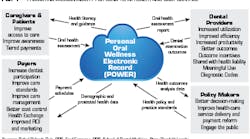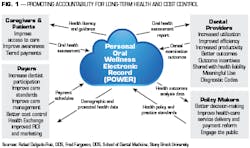BY Fred S. Ferguson, DDS
Neither our health culture nor our health-care system sufficiently engages people to be accountable for their oral health. This lack of accountability is largely responsible for escalating health disparities and costs for common chronic illnesses.
Beginning with childhood, the mouth reveals risk concerns to overall health and wellness. Poor oral health can be linked to the most common chronic health problems. The risk factors (e.g., habits, lifestyle choices, diet, self-care, and child-care) for poor oral health are well understood and are intimately linked to overall health and wellness.
It would be logical to capture information about consumers' risk factors and compare these concerns to their dental examination outcomes as a method of engaging consumers and providing valuable information to payers. This approach would go a long way to guide effective preventive care, promote accountability, reduce cost and fraud, improve population health, and reduce health disparities. It would also help create effective public health policies and practice standards.
The Patient Oral Wellness Electronic Record (POWER), an online, interactive health management tool, is an effective and efficient vehicle to create the following. (1) Accountability: Consumers self-identify their oral health behaviors of concern and build awareness, confirm their oral health statuses via timely dental examinations, and take responsibility for their behaviors of concern. (2) Smart Data: Empowers providers, payers, and consumers to collaborate and achieve a more impactful, less expensive health care system. (3) Guidance for Long-Term Health: Consumers can promote their health over time.
The overarching benefit of the POWER is to reduce health-care costs, maximize health potential, facilitate better treatment outcomes, and improve care management.
Vision: The POWER can be an efficient and effective tool for health promotion, long-term health, and cost control. Consumers/caregivers create a password-protected and personalized health folder in the POWER. They respond to age-specific oral health questionnaires and receive personalized health guidance specific to their self-identified oral health concerns (i.e., habits, lifestyle choices, diet, self-care, etc.). Responses and data are saved in secure health folders. Consumers (and dependents) present for "timely" dental visits with the purpose of providing data (the diagnosis) to the POWER. The information is based on their dental examination, during which time they receive preventive health care. The dental provider completes an examination outcomes questionnaire, which also provides evidence-based guidance to the patient (or caregiver) based upon the outcomes of their examination. Access to dental care (i.e., timely utilization) would increase as payers would desire this data. Repeated use of the POWER would promote accountability to promote short-term and long-term health and cost control to the payers as shown in the figure below. The POWER would make the patient the center of his or her health management.
Strategy: Good oral health management is an effective strategy for consumers to gauge and track their overall health. Beginning in the first year of life, poor oral health is the most prevalent chronic health concern over the life span. Good oral health begins with awareness and timely preventive dental visits. Non-genetic risk concerns (i.e., lifestyle choices, habits, diet, self-care, child-care, etc.) are the predominant cause for common chronic health problems (i.e., diabetes, heart disease, high blood pressure, obesity, etc.). Except for obesity, common chronic health problems are not observed until adult age. With increasing age, common chronic health problems and poor oral health commonly happen together, are linked via shared risk concerns, tend to happen in families, and occur predictably in disadvantaged communities. Timely preventive dental visits have been shown to be beneficial for overall health and wellness.
| The Stakeholders View of The Power |
Caregivers/Patients (Consumers) |
| Dental Providers Receive information about their patients' oral conditionsand related behaviors Provide information about the patient's dental examination findings |
| Payers Receive information about the consumer's oral conditions, related behaviors, and dental examination findings Provide tiered payment schedules for consumers |
| Policy Makers Receive health outcomes data Provide public health and practice standards |
Operational Expectations: How the POWER works and what consumers can expect from the POWER. All consumers would have 24/7 access to the POWER. All consumers who have health insurance would be required to use the POWER. Consumers (and caregivers) would create a password-protected oral health folder, complete the oral health assessments, and receive personalized health guidance over time. Timely utilization would be a requirement of the POWER, and data from the dental examination would be inputted by the dental provider in consumers'/patients' POWER. Consumers would receive email alerts regarding dental visits based upon the consumers' or dependents' last self-assessments and dental visit examination outcomes from the POWER. Consumers would receive email alerts for preventive care (e.g., sealant therapy for children) based on age and self-identified health parameters. Consumers would input the email contact of their health providers (dentist, obstetrician, PCE, etc.), who would receive oral health summary reports based on consumers' or dependents' "Oral Health Assessment Data" and "Dental Care Examination Data." Consumers would input the email contact for their payer (unless they have no insurance). Consumers would have ownership/use of their POWER health folder, so that no matter how their situation (e.g., insurance, employer, location) changes, they would maintain access to their personalized and secure health folder in the POWER.
POWER Constraints: The POWER should be available from the government so that all consumers would have access regardless of their situation. In the U.S., health care is presented and controlled via business entities or employment benefit programs. Many consumers do not have access to or do not use health tools. This situation contributes to health disparities, poor utilization, lack of health integration, and escalating costs. Corporations could also be engaged as partners to provide the POWER (co-branding). Business entities (e.g., foods and oral health products) can also license the POWER.
This is the first of a series of articles to detail a solution to reform and enhance our failing health-care system. The next article will provide details about the data developed from the POWER.
Fred S. Ferguson, DDS, is a Distinguished Teaching Professor in Pediatric Dentistry, Department of Orthodontics and Pediatric Dentistry, and Director of the Advanced Education Program in Pediatric Dentistry, School of Dental Medicine Stony Brook University. Dr. Ferguson is the creator of online tools to promote accountability for long-term health and cost control.







